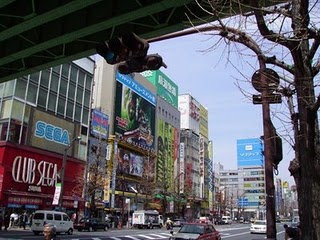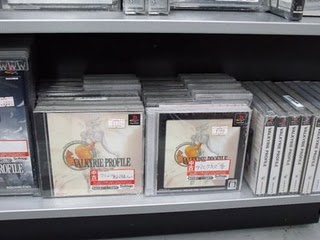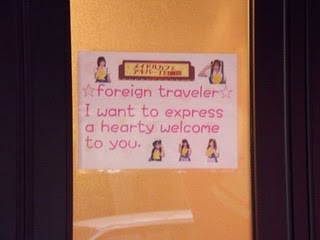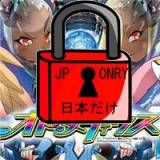Strategy Guide to Buying Games in Akihabara ^.^
By akakaze 10 Comments

If you're a nerd, and you're visiting Tokyo, then I can only assume that one of your first stops on your whirlwind Japan tour will be Electric Town Akihabara...and why wouldn't it be? This neon district of electronics stores, arcades (some of the most famous in the world), Japanese junk food, maid cafes, and quirky manga/anime retailers makes up one of the most characteristic - if not sterotypical - places to explore in Tokyo. But TRAVELER BEWARE! Although Akihabara is generally fairly easy to get around as a foreigner, in general you need to be careful where you go and what you buy - it's easy to get caught up in the chaos only to regret it later.
Have no fear, akakaze is here!
How to get there: Yamanote line. Easy. Three stops from Tokyo station (you can also use the Chuo Line express to cut out a large portion of travel time if going from Shinjuku). But for those unfamiliar with the trains, your friendly neighborhood JR station staff should be able to point you in the right direction, as most of them speak enough English to be able to assist you. All ticket machines have English modes on them, so there really isn't a whole lot of explanation I can give you regarding how to get there. The important things to take note of occur once you arrive.
Now, the first thing you'll probably notice upon stepping out of Akihabara JR station is the maid cavalry...tons of college students dressed in French Maid costumes... which will be doing their best to get your attention, advertise their businesses, and hand you free packages of tissue (which is used because many public bathrooms don't supply TP or towels). Keep in mind that some of these maid businesses are more reputable than others, and although I'm far from a maid business expert I've noticed that the less English is in an advertisement you're handed, the more likely it is to be shady. I still have the handout I was given during my first trip to Akihabara for "Cutie Relax Maid Massages". I don't even want to know. Seriously. I don't.
Ideally, you want to just smile and walk by, and don't take their handouts unless you really want to. Chances are you're not here for that anyway, which leads me to: the stores.
Now, I'm going to go out on a limb here and say that you're here to buy games. Are you? Good. Now here's the bad news: aside from the region lock issue which affects every console except the GBA, DS, DS Lite, PSP, and PS3, purchasing brand new games will in general set you back far more money than stateside equivalents. A new game can go for 6800 Yen ($70) or much more than that for some Square-Enix titles. Fortunately the rule of mass depreciation doesn't only apply to cars. It applies to video games as well. You can quite regularly find complete games on sale for much much less than retail price. And it happens much, much more quickly than in the states. A game a few weeks old can sell for 30% or more off MSRP in some cases. Each retailer sets their own prices for both new and used games as well.
If buying new (consoles or games):
1.) SHOP AROUND! Remember what I told you above - retailers very often set their own prices, which means something selling for 5800 yen one place might very well be in the bargain bin down the street. Usually price variations are extreme - the only time when stores seem to universally charge the same price is when a game is first released (and as such, they can gouge). The price differences can be attributed to the presence of TONS of competition, unlike in the States. Use that to your advantage.
2.) Know your system. Most have region locks - so you'll either need a Japanese console or a means of circumventing the lock if you want to play them. Good Japanese store clerks will point this out to you as best they can, but most won't bother. Since you're in Japan anyway, you might as well get the systems too...(at least I did) -_-
If buying used (games):
1.) Read the signs! Unlike Gamestop, JP retailers do you a great service. They not only tell you that a copy of a game is used, but they list any particular problems the game or packaging has. Depending on the condition of the individual item, pricing will vary. Thus, if you just want something to play and don't care about packaging, you can get some insanely good deals. Even games with most packaging intact are sold for at least 20% off MSRP - in many cases a lot more. Unfortunately, these "condition notes" on each game are often written in "Japanese gamer dude scribble" which is, in my opinion, the most difficult handwriting to read in the world - period. Yes, worse than doctor prescriptions. Much, much worse. Here are some terms which will help you here:
中古
CHUUKO/CHUUBURU = "second-hand", "used"
ディスク
DISKKU = "disc"
新しい
ATARASHII = "new"
ゲーム
GEEMU = "game"
キズ
KIZU = "wound", "scratch" (in the case of a game, refers to disc scratching or damage)
多い
OOI = "lots of"
なし
NASHI = "without", "not present"
If you can probably tell, the phrase on a game that is a dead giveaway that you really don't want to buy it is: ディスク キズ 多い (you can figure out what it means from the list above I'm quite sure).
Often the notes are written just like above, not in sentence format.
2.) Know what you're getting. A game that has a rare US version may not be as rare in Japan. Hence tons of copies of PS1 Valkyrie Profile available at 780 yen ($8 each - here's the evidence)

Other interesting finds: complete boxed copies of FFIV - VI for Super Famicom @ $20 each, complete boxed copies of Chrono Trigger @ $15 each, complete Secret of Mana I and II @ $18, and Ogre Battle 64 - brand new and wrapped....in the bargain bin for $5. THE BARGAIN BIN! So remember, kids: if it's big in Japan, it's probably not rare in Japan. Don't think your copy of JP Chrono Trigger will fetch that same $100 on Ebay that the US copy will. Of course, if you're buying them to keep, or to play, as opposed to sell, then it's probably worth picking some of these classics up. Just don't expect to be rolling in the dough.
Useful phrases (including the "summon spell" from ordering from restaurants- which also works here if you need a cashier or clerk's attention!):
「すみません!!」
SUMIMASEN = "Excuse me..." ("summon spell" mentioned above, causes waiters or store clerks to drop what they're doing and run over to service you)
「何かを買いたいんですが。。。」
NANIKA WO KAITAI N DESU GA... = "I would like to buy something, but [I need your help]"
「これは、いくらですか?」
KORE WA, IKURA DESU KA = "How much is this?"
「VISAを使っていいですか?」
VISA WO TSUKATTE II DESU KA = "Can I use my VISA?" (They might say no, in which case they'll probably respond with something like 「現金だけでございます」 , cash only please... the word for cash is GENKIN).
So after you're done with your game shopping, you're probably going to be hungry. Now there are plenty of food stands in Akiba selling Crepes, Takoyaki, Ramen, etc...but if you want the full Akihabara experience, you should probably try out a maid cafe at least once. Now, the maid cafe is a part of Japanese culture that is very, very difficult to explain. Basically, it started as an innocent way for socially awkward Japanese men to part with money in exchange for conversation with women dressed up as maids or other anime stereotypes. The idea was to pull the customers into a fantasy (INNOCENT fantasy that is) of being in an anime - and give them the chance to interact with people that they normally wouldn't either due to shyness or other reasons. The phenomenon exploded out of Akihabara and now there are all types of theme cafes that have more or less the same purpose.
I guess if you have to compare it to anything, think of it as the Japanese version of Hooters without the hooters...erm...so to speak. The food really isn't that special but it is a unique Akihabara experience. I can't say I'd ever go back (especially after my girlfriend heard that I went innocently on a suggestion from a friend), but it was definitely unique. And the clientele has expanded beyond just lonely guys into a socially acceptable form of restaurant for people of both sexes and (almost) any age....

erm.... *gulp*
